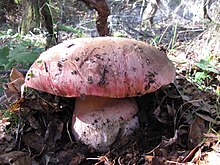Rubroboletus eastwoodiae
| Rubroboletus eastwoodiae | |
|---|---|

| |
| Scientific classification | |
| Domain: | Eukaryota |
| Kingdom: | Fungi |
| Division: | Basidiomycota |
| Class: | Agaricomycetes |
| Order: | Boletales |
| Family: | Boletaceae |
| Genus: | Rubroboletus |
| Species: | R. eastwoodiae
|
| Binomial name | |
| Rubroboletus eastwoodiae (Murrill) Vasquez, Simonini, Svetash., Mikšík, & Vizzini, 2017
| |
| Synonyms[1] | |
| |
| Rubroboletus eastwoodiae | |
|---|---|
| Pores on hymenium | |
| Cap is convex | |
| Hymenium is adnate | |
| Stipe is bare | |
| Spore print is olive-brown | |
| Ecology is mycorrhizal | |
| Edibility is unknown | |
Rubroboletus eastwoodiae, sometimes (but inaccurately) called satan's bolete,[2] is a possibly toxic basidiomycete fungus of the bolete family.
The cap is 6–25 centimetres (2+1⁄2–10 in) wide, convex,[3] olive-colored, pinkish in age, dry, has margin that curves inward then expands, and yellowish flesh.[4] The stalk is 7–15 cm (3–6 in) tall and 3–6 cm (1+1⁄4–2+1⁄4 in) wide.[4] The flesh turns blue when cut.[4] The spores are olive-brown, elliptical, and smooth.[4] The spore print is olive brown.[3]
It is closely related to Rubroboletus pulcherrimus. It looks similar to but is genetically distinct from the European species R. satanas.[2] It is also similar to R. pulcherrimus and Suillellus amygdalinus.[4]
It occurs under oak on the West Coast of the United States from November to January.[3]
The edibility of the species is unknown; it may be poisonous.[4]
References
[edit]- ^ "Record Details: Rubroboletus eastwoodiae (Murrill) Vasquez, Simonini, Svetash., Mikšík & Vizzini". Species Fungorum. Retrieved 2018-10-27.
- ^ a b Mykoweb.com: Rubroboletus eastwoodiae
- ^ a b c Audubon (2023). Mushrooms of North America. Knopf. p. 357. ISBN 978-0-593-31998-7.
- ^ a b c d e f Davis, R. Michael; Sommer, Robert; Menge, John A. (2012). Field Guide to Mushrooms of Western North America. Berkeley: University of California Press. p. 321. ISBN 978-0-520-95360-4. OCLC 797915861.
